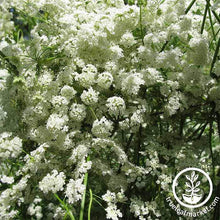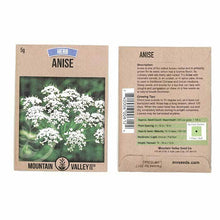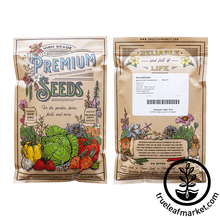Non-GMO Anise Herb Seeds. Open-pollinated, Heirloom. Anise is native to the Mediterranean, North American, and Asian regions. Anise has been known to aid in an upset stomach and cough. Used by Native Americans to freshen breath, chewing leaves and stems after a meal. Used also in soaps, perfumes, and sachets because of its aromatic properties. Anise does best in regions where the soil is approximately 70 degrees.
Anise Garden Planting Seeds
Anise herb plants (Pimpinella anisum) will reach heights of 18-24 inches and display large primary and feathery secondary leaves. Clusters of tiny, yellow-white flowers appear in midsummer, followed by ribbed teardrop-shaped fruits called Aniseed for which this is herb is famous.
Anise herb garden seeds are the most widely used part of the plant. Though its leaves, too, are tasty and can be snipped off and added to salads or sprinkled over finely chopped vegetables. Whole or crushed the Anise seed kernels can be added to breads, cakes, cookies, applesauce, soups, or even beverages.
Anise is used as a medicinal herb for a variety of reasons it can be used for medical purposes such as upset stomach, intestinal gas, and a runny nose. It can also be used as an expectorant to increase productive cough, as a diuretic to increase urine flow and as an appetite stimulant.
Anise is also used as a flavoring agent. It has a sweet, aromatic taste that resembles the taste of black licorice.
\ Seeds Per Package:- 4 oz - Approximately 45,000 Seeds
- 1 lb - Approximately 180,800 Seeds
- 5 lb - Approximately 900,000 Seeds
Variety: Anise
Other Names: Anis, Aniseed, Anisi Fructus
Seeds per Oz: Approx 220
Days to Maturity: Approx 79
Features:
Non-GMO: Yes
Organic: No
Heirloom: No
Treated: No
Pelleted: No
Hybrid: No
Open Pollinated: Yes
Plant Type: Annual.
Hardiness Zone: 5-9
Uses: Household herb, tea, spice
Temp Preference: Warmer
Light Preference: Full Sun
Resistances: None
Comments: This favorite household herb has been used for nearly 3,000 years.
| Seed Planting Depth | Seeds per Ounce | Germination Temperature | Days to Germination | Row Spacing | Plant Spacing | 100' Row Yield | Sun |
| 1/8" | Approx 220 | 70 degrees F | 14 | 2-3" | 12" | N/A | Full Sun |
Sowing: Soil needs to be above 70 degrees to germinate in about 14 days. Clear garden bed of weeds, roots, and other pieces of debris before direct sowing. Keep the area moist for best germination. This herb requires regular watering, but be sure to check the soil with your fingers for moisture. Water consciously--if the soil is adequately moist, hold off on watering until the soil has dried a bit. It does best in an area that is free of weeds, roots, and other debris. Anise needs to be watered regularly until the plant is established and then it can tolerate periods of drought.
Transplanting: Anise is not a plant that can be transplanted it does not do well. Always start directly in the soil that it will stay in.
Harvesting: Producing Anise seeds requires a long hot growing season. Harvest by cutting stems below the flowers and if the seeds are still green and not fully dry, tie flowers together and hang upside down. Otherwise, the stems and leaves can be harvested throughout the season.
Soil Preference: Anise does best in moderately rich soil that has been well-drained.
Other Tips: Start them in warm days in May they require a soil temperature that is about 70 degrees.
Heirloom Anise herb gardening seeds.





